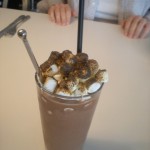Southern fried
Okay, so Atlanta, being in the South, has a lot of fried food. This is true. I think I had something fried with every meal I ate in my week-long trip. However…there is also some seriously good food in that place. I’m talking Atlanta and the lesbian-infused suburb of Decatur. Here are the highlights from the trip’s food log. Food pretty much fell into three categories: Breakfast, veggie burger, and fried. There was some overlap. There were also a couple of healthyish meals thrown in for good measure.
Breakfast:
My first day there, my hostess, Kelly, took me to one of the best breakfast spots in town: Highland Bakery. (It just so happens, it’s gay-owned, too. Joy!) I’d been there about 7 years ago when I last visited Atlanta. It was good then, but now it’s bigger, better and even more delicious.
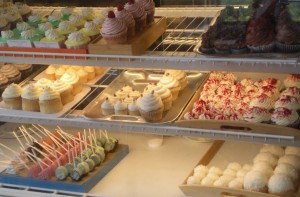
What’s better than being greeted by a cupcake-laden pastry counter? Not much really. Unless it’s a mini-muffin sampler!
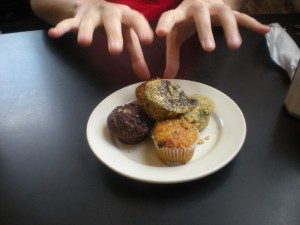
Yeah, that was good.
The actual meal was a breakfast sandwich of some kind for Kelly, and the breakfast burrito, recommended by our waiter. I’ll have to go back to try the Hoppin’ Highland.
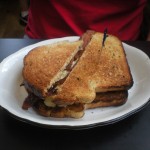
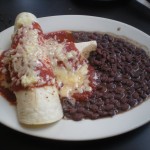
Pretty much every day, I headed to the Dancing Goats for coffee and bagels. Mmmmm, bagels. I hadn’t my usual bagel fix for over a month, so I was really excited to encounter the hand-made, wood-fired bagels at Dancing Goats.
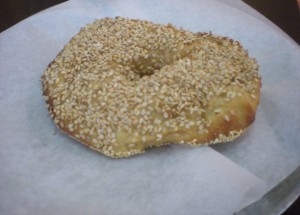
Not to mention the world-class coffee. (There are only two Dancing Goats coffee-shops, despite the coffee being sold everywhere.)
And then there were donuts. I heard there was a place that’s been compared to Voodoo Donut in Portland. I knew it couldn’t actually be like Voodoo. That’s not possible. It was, however, delicious.
Housed in a non-descript strip-mall of a building, Sublime Donuts turns out gourmet donuts. We chatted with the owner who, when asked for his favorite, waived his arm dramatically and declared “all of them!â€Â Kelly had the caramel-apple fritter.
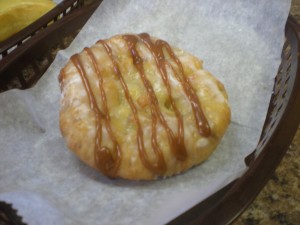
And I signed up for a red velvet cake and an orange dream star.
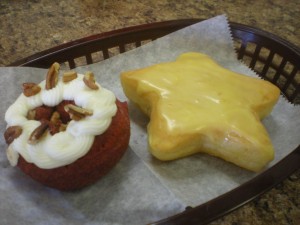
The red velvet was topped with cream cheese frosting and pecans and the orange dream star was filled with creaminess and topped with a delicate, sweet orange frosting.
Next there were the sweet potato waffles at Rise and Dine. Kelly raved about these things from the second I got in until we had them. And then a little after that.
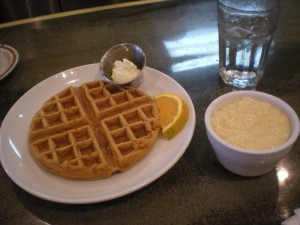
She had hers with bacon. I had mine with Jalapeno cheddar grits.
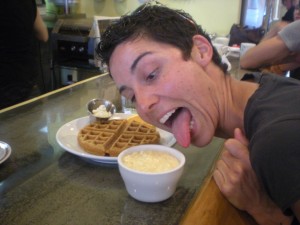
Turns out I’m a grits girl.
Which I proved again and again, next at The Flying Biscuit. This place used to be owned by the Indigo Girls. Now it’s not, but it’s tasty. I had this:
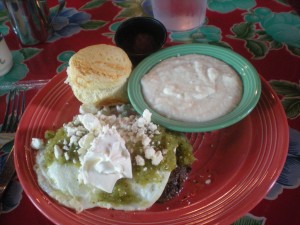
It was black bean patties, over-medium eggs, tomatillo salsa and feta cheese. With a side of cheesy grits. And a biscuit. And homemade jam. O. M. Y. Oh my yum. This is possibly the best thing I ate in Atlanta. At least for breakfast. Don’t be dirty.
The award for most beautiful breakfast in Atlanta came from Rise ‘n’ Dine. I made a return trip. This time I had a scramble with tomato, goat cheese and basil. It came with a beautiful biscuit and house-made, no-sugar-added jam. It was terrific. And pretty.
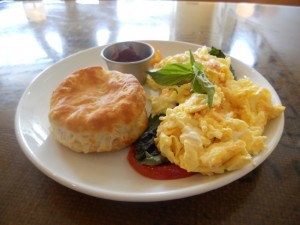
The least delicious, but most interesting breakfast was at IHOP. It’s been years since I had eaten at an IHOP. I was a fiend in college. Currently, IHOP has a 600 calorie or less menu. I’m really not sure how many people in the house were eating off of it, but my other hostess, Linda, and I were. Not a bad meal, in fact. Harvest Nut and Grain pancake, egg substitutes and a banana.

The other quasi-healthy, and much tastier meal I had was at Kelly’s place. She and her partner cooked for me. The takeaway from the meal was a recipe for kale chips. Yep, kale chips. If you rip kale into potato chip sized pieces, place them on a baking sheet, drizzle with olive oil and sprinkle with salt and pepper, and then bake at 400ish until they’re crispy, you’ll be delighted. It’s almost like a potato chip. But healthy. And kale.
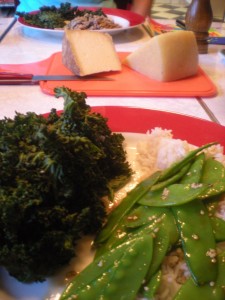
I’ve since learned that you can add a bit of mustard to give it a zing. Paired with cheese I brought back from Italy, we had a darn good meal.
For other healthyish meals, I hit ragin’ tacos for a plate of delicious tofu tacos,
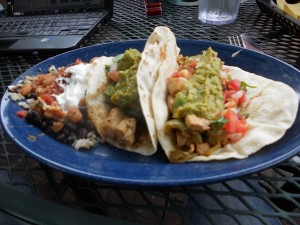
and Lotta Frutta, an excellent, exotic fruit smoothie bar. I had a guana smoothie and a grilled cheese.
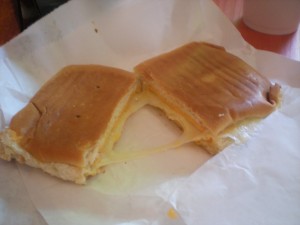
The sandwich came with seasoned corn bits that I would, oddly enough, experience a week later in Peru.
Veggie burgers:
I was pleasantly surprised by the presence of house-made veggie burgers on menus all over the city. Some of these were seriously good. Some of these were seriously fried. Some of these were served in restaurants I will not frequent.
The first was at Joe’s on Juniper, a gay sports bar with a great outdoor seating area.
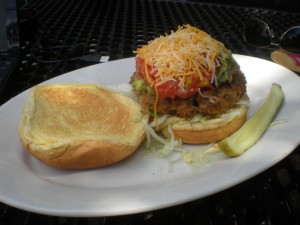
The burger was house made with black beans, and fried. It was tasty, but fell apart in my hands, which irritates me, truth be told. I sat on the patio and listened to labor protestors across the street. My waiter apologized, but I had good time listening to the chants.
That same night, Kelly took me to a fancy burger bar, called Flip Burger. I only tell you the name so that you will know that it’s the place that serves fois gras. For that reason, I won’t, personally, go back. The burgers were good. Mine might have been fried, I don’t recall, but it was topped with pickled onions, goat cheese, and microgreens. Kelly had a bacon cheeseburger.
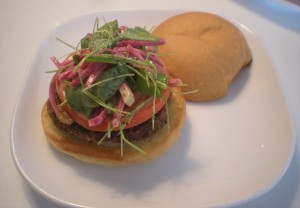
The real purpose of the trip, however, was the milkshakes. Kelly’s was toasted marshmallow, and mine was turtle. Neither of us opted for the goose-liver pate option…
While we were there, we ordered a tray of fried pickles.
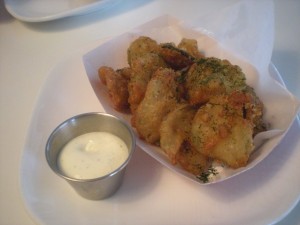
Yes, they were good. They were bread and butter, and came with some kind of buttermilk dipping sauce. I’ve always pictured a fried pickle as a whole pickle, dropped into a deep fryer. That’s not what these were. They could have been bread and butter shoeleather, fried and slathered and they would have tasted good.
Much like the fried okra I had a couple of days later at a place called Farm Burger.
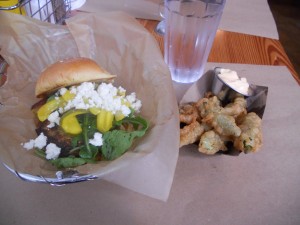
This had some kind of chipotle dipping sauce. I think I liked this veggie burger best of all. It was fried and fell apart, but it was quinoa. I like quinoa. It’s another grain I saw a lot of in Peru… Paired with the sweet pickles and goat cheese, the burger was nice. It went down smoothly. Which is good, because Farm Burger also serves ice cream floats. I had a ginger beer one.
While the award for best veggie burger goes to Farm Burger, the award for best fried food goes to Watershed.
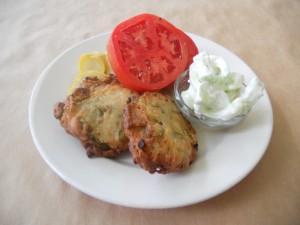
That’s an okra pancake. Actually, it’s two of them. Chopped and battered and formed into cakes, the okra retains some of its former glory, the tapioca-sized seeds bursting in your mouth. But it becomes more. It’s far better than the usual fried-okra, which is pretty darn good. It was delicate and crispy. It didn’t hit me over the head with its okraness or its fried nature. It was just simple and good. Like everything else on the plate. There was no surplus. The heirloom tomatoes were simply seasoned with salt and pepper. The cucumber salad was dressed with crème fraische. I left full and happy. Plus, it was at Emily Saliers place, Watershed. So it was staffed by cute girls, and had a certain lesbian sensibility about it.
While I ate well the whole time, there’s one meal that stands out. After a long day of writing, I was hoping to grab a piece of pizza and head back home. Only, on the way to the pizza place, I got sidetracked by a menu in the window of the Iberian Pig.
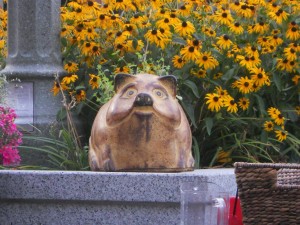
That’s the pig. Or it’s A pig. Might not be the actually Iberian Pig. Unclear. What was clear was that the food was divine. Peaches, quinoa and churros. If you want more detail, you’ll have to wait. This place deserves its own post.
July 22, 2010 2 Comments
Stone-fried hospitality
When I first decided to go to Peru within a week of returning from Italy, I thought it would be a good idea to spend the week in between back in the states. It seemed the culture shock of first-world Italy might be a little much next to the unfamiliarity of third-world Peru. But Portland, my home base, is on the other side of the country from my entry point on the East Coast, and I’d be traveling with a friend from Atlanta, so I thought I’d spend some time there. In the South.
Now, I know that some of you are saying, “Atlanta’s not the South!â€Â Well, it is. For someone from Portland, it’s the South. I like Atlanta, but it might have been less of a shock to head directly to Peru, where the language difference would have alerted my brain that I was, indeed, in a different country/culture. Spending a week in a place that looked and sounded somewhat familiar was just enough to make me feel like I was losing my mind. I spent time searching for the gayness that I’d missed so desperately over the last month, and finding fried food
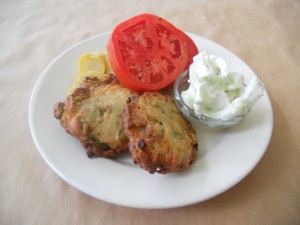
Stone Mountain
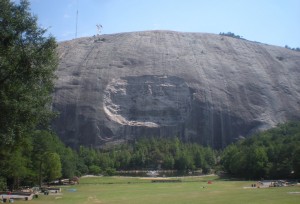
and slow-talking hospitality.
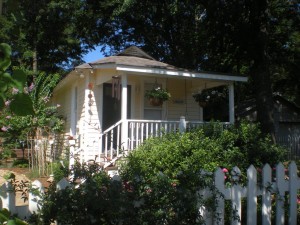
Total strangers put me up in their beautiful guest-house. Amazing.
I even found some of the gayness, too.
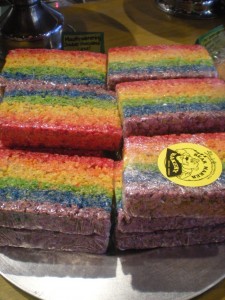
But that just contributed to the feeling of being constantly off-balance. I could read the menus, but couldn’t anticipate the constantly fried preparations. I could navigate the nature hikes, but couldn’t absorb the confederate flags along the trail. I still don’t know if it’s good or bad etiquette to take pictures of confederate monuments, or if there’s a reason to put fois gras in a milkshake. Anyone? Anyone?
July 21, 2010 4 Comments
Cultural exchange
The Amalfi coast is definitely known as a place to see in Southern Italy. In the months running up to the trip, every time I mentioned that I would be in the south, I got the question, “will you see Amalfi?†or the command, “make sure you go to the Amalfi coast.â€
Like the Cinque Terre, the Amalfi coast is known for its jewel-like villages clinging to the coastline. We decided that the best way for us to experience the towns would be by boat. The boats that serve the cities up and down the coast are great. Varying in size and fanciness, they take travelers the direct route, on the water, from one city to the other.
This was a new form of transportation for us, requiring us to locate the ticket office, dock and slip. A stop by the information office insured we were headed in the right direction.
Once on board, we scoped out the best seats: ground floor, starboard side, toward the front – just opposite the helm. This gave us a good view of the coastline, and the captain, who was very friendly.
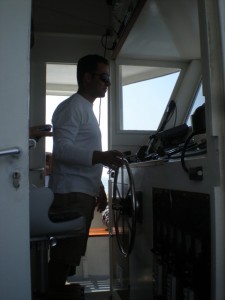
I think he liked the Ant. In the way only an Italian captain can look, this guy was both weather beaten and stylish. His face was worn, under his designer sunglasses, and metallic trainers distracted from the flesh-toned medical sock running the length of one leg. He kept leaning out of the cockpit, pointing to the coastline and throwing out the names of the towns.
“Cetara. Positano. Atrani.â€
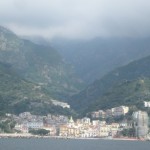
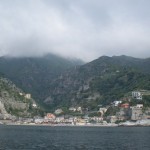
Along with the towns, their majolica-tiled cathedral domes blending together, we were treated to views of ancient lighthouses, and caves.


Finally, our captain friend leaned out and said, “Amalfi!â€
Amalfi. That was our destination for the day. First on the list: cappuccino.
We hadn’t had much in the way of breakfast, opting instead to catch the early boat. Now we needed to find a pastry shop that we liked the looks of. We walked through the town square, past the cathedral, and into a shop with pizza and baba in the front window.
“Due cappuccino, per favore.â€Â I walked over to the pastry case to see what I could find. “E una di questeâ€Â I pointed to the bready things that looked like popovers.
“Normale?†asked the proprietor, a round man with shaggy white hair.
“Si.â€Â I had no idea what the alternative was, but the cream-covered plates in the case looked a bit over-the-top. Even for me.
He pulled one of the pastries out and put it on a plate. Then he drenched it in some kind of liquid from a stainless steel bottle, and handed it to me.
“Grazie.â€Â I took my prize over to the Ant who was waiting at the bar for the cappu.
“Look at this.â€Â We both stared at it in awe. We didn’t know what we had, but we were appropriately excited.
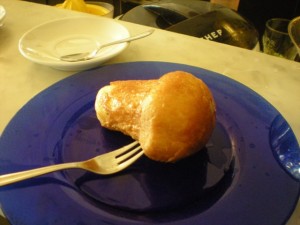
Baba is a regional pastry that is drenched in rum. Not so much my bag, but it was tasty, nonetheless. With our cappuccino in front of us, we settled in for the caffeination we so desperately needed.
“Buon giorno.â€Â The young man behind the counter was smiling at us, looking up from cleaning the marble slab. He looked curious. “Where are you from?â€
The familiar question was slightly amusing. He’d guessed the language, surely he could guess the country.
“The United States. America.â€
“Si, si. But where?â€Â Ah, he’d already figured it out.
“Idaho, Oregon. The west.â€Â Sometimes people have heard of Oregon, but almost nobody knows Idaho. Even in the US, Idaho, Iowa and Ohio are interchangeable for the vast number of Americans.
“Ah, but you are Italian? You look Italian. I think, you look Italian, but something is not right.â€
“Yes! Our family is Italian.â€Â We’re more than happy to share this information with anyone who shows an interest. It gives a little cred. (I’m sure the “not right†was our shoes.)
“You stay in Amalfi?â€
“No, Salerno.â€
He shook his head. “Next time you stay in Amalfi. This is my town. I show you. You will be here tonight?  You come back, I will be your tour guide. I will show you everything. Right now I have to work, but tonight, you come back. What are your names?â€
He was animated, looking intently from one of us to the other, sincere in his interest to show us his town.
“Kristin.â€
“Leslie.â€
He repeated the names. “Lezley.â€Â He worked it out, the name an unfamiliar one. “Kreesteen.â€Â My name, so close to the Italian equivalent, is almost always converted to Christian. I went by “Kris†a lot the last time I was here. It’s not something I accept very often in the states, but in Italy, it seems to fit.
“I am Nicola.â€
We both repeated. “Neecola.â€
“Kreesteen, you will return tonight?â€Â He was grinning, awkwardly, but determinedly.
“Forse, Nicola. Forse no.â€Â It was possible, though unlikely. I didn’t want this sweet boy to get his hopes up. They were definitely on the rise. Flattering, but hard to have to manage his expectations while we stood there drinking cappuccino. “Torniamo a Salerno.â€Â We would be going back to Salerno.
Done with our coffees, we pushed the cups toward Nicola and smiled.
“Kreesteen, I hope you will return tonight. I will hope to see you.â€Â Apparently his expectations weren’t going to be managed.
“Ciao Nicola. Grazie.â€
We stepped out of the shop into the sunlight and walked back to the cathedral.
“Wow, he liked you,†crooned the Ant.
“Yes, he was very sweet. I hope he’s not too sad when we don’t come back tonight.â€Â I really don’t like making sweet boys sad. It’s usually the sweet ones that unwittingly fall for me, developing puppy-dog crushes and making me squish their hearts a little.
The cathedral was on our list of things to see, so we walked up the zillion stairs to the entrance, noticing the colorful rice bits strewn everywhere, and a hunky guy with a messenger bag.
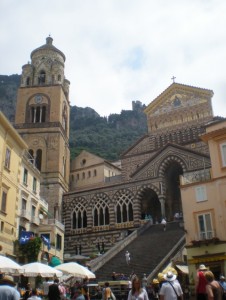
“Did you see him?â€Â I asked the Ant. “Go back and look. He’s hot.â€Â The Ant is single, and Italian men are fun eye candy. Even for a big-ole lesbian like me. In the states, 90% guys looking like this would be gay. And I love my gays. So, even though I usually make a point of not giving false hope to my family by talking about cute men (I’d once gotten a call from my sister, chastising me for telling my mother that I was going to have my “gay husband’s†baby. “What, exactly ,did you tell Mom?!â€)  it had been fun to point out the extra-yummy ones to the Ant and see if she agreed. She doubled back and took a peek, pretending to take in the building.  This one was a little to smooth for her. So we headed inside.
The art and architecture inside was fine. We saw beautiful, delicate columns, and an over-the-top tomb decorated in marble and gold. Most of it we passed by without much consideration, as our stomachs began to churn. Cappuccino and rum-soaked baba wasn’t really enough to sustain us through much sight-seeing.
Back in the street we considered where to go for lunch. We’d seen pizza, but nothing had really grabbed us.
“We could always go to Nicola’s place.â€Â The Ant was smiling and looking at me out of the corner of her eye.
“Yeah, we could.â€Â I wasn’t up for too much in the way of game-playing. “But let’s not.â€
Amalfi isn’t that big of a town. We walked up the main street, away from the water until it became distinctly un-touristy. Good for a peaceful walk, but not good for food. Back into town we jogged, the hilly street propelling us downward. We dismissed take-out places, in favor of somewhere we could sit, rejected the feel and price of several, and climbed a set of stairs to an interesting prospect, only to find it closed.
“Nicola would like to see you.â€Â I didn’t respond to the statement from the Ant. “You know you’re not going to live that down for a while, right? But it’s only because I love you.â€Â She was nudging me affectionately with her shoulder.
“You love me, so you taunt me?â€Â I answered sharply. The lack of food had pushed me over the edge. “It’s not so fun for me. Here, this place looks good.â€
Finally, we’d found a pizza place that passed muster. We sat in the courtyard, and I breathed a little.
“I’m sorry I snapped. It’s just difficult.â€Â I felt like I owed her an explanation. Like I wanted to give one. “Think what it’s like to have beautiful, kind, sweet boys take an interest in you. To have them flatter you. And then to have to embarrass them, or to break their hearts just a little. Over and over. It’s not so fun.â€
She was looking at me with big eyes, nodding faintly.
“And then imagine what it’s like to be me, knowing that, every time a guy hits on me, whether it’s Nicola, or a gas station attendant, that my family wishes I’d accept. That they wish I would say yes.â€
Both of us were tearing up now.
“It’s hard. And it makes me unwilling to do things like point out hot guys.â€
We paused to order lunch, both of us breathing deeply, knowing the conversation was a good one. A hard one.
We talked about the day, years ago, when I had come out to the Ant, the concerns she’d had, and the great journey of acceptance she’d traveled (she loves the gay men almost as much as I do).
Our pizza arrived, and we were more than a little happy.
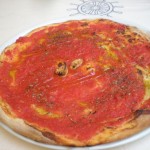
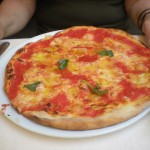
The food was beautiful and really good. We were so hungry that we even ordered dessert. A gorgeous pine nut torta with strawberry sauce.
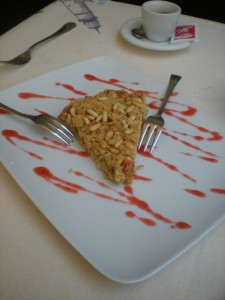
The rest of our day was filled with a tour of the paper factory, given by another sweet boy named , Rafael, and a hike to the nearby town of Atrani.

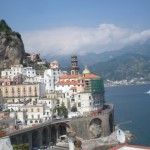
The Ant and I were gentle with each other. I didn’t snap again, and she didn’t mention Nicola. We simply walked together through the sweltering day, shared a giant bottle of water, and went home to make dinner.
We didn’t talk about boys again until the next day, when we were walking to the bus station.
“So, I’m thinking,†the Ant started, a look of determination on her face, “that in this journey of acceptance I’m taking,â€Â I looked at her, interested to hear the rest, “that it would be good for you to tell me when you see someone who is cute.â€Â  Okay, I could do that. “Like you could say, ‘she’s really attractive’ so that I could get an idea of what type you like.â€
Oh! She wanted to know what type of women I liked! Wow.
“I mean, maybe don’t go on and on about it, but…†she was a little flustered, her brow furrowed and her hands extended.
“No, I won’t talk about how I want to slap her ass or anything, but sure. That would be fun. Kind of like a cultural exchange.â€
We looked at each other and laughed. It wasn’t enough that we were traveling through Italy. This would be our cultural experience: eyebrows lifted toward hot women, and fingers covertly pointed at yummy guys. And not another mention of Nicola.
June 22, 2010 3 Comments
Butch dikes…please explain. I’ve known and worked with a few, and I view them as another man. But, when it comes to the lesbians that love them….what’s the difference between a very masculine woman and a slightly effeminate man? Other than the obvious plumbing?
Thanks for the question, Carl. Before I start, this is a good time for me to remind everyone that I’m not an expert, per se. I am a lesbian, but I don’t have a degree in gender studies, and I’m not a doctor of psychology. What I have to say comes from my own experience, or the experience of friends, when noted.
Let’s take a minute and flip the script. Is there a difference, for you, between being married to a woman or a flamingly effeminate man? Even someone who dresses in women’s clothes? Someone with long hair and a soft body?
The plumbing is pretty important to me, and I’d wager it’s pretty important to you. What we’re talking about here, though, more than sexuality, is gender norms.
I’ve said for a long time that it’s not the sleeping with people of the same sex that gets the gays into trouble, it’s the messing with gender norms. I can’t tell you how many times I’ve been asked, “which one of you is the boy?â€
For me, the answer has always been, “neither,†but the fact that I keep getting the question shows that there’s an expectation that a relationship will have a male-acting partner, and a female-acting partner. Even if both partners are the same sex.
Let’s break down your question:
I’ve known and worked with a few [butch dykes], and I view them as another man.
Do you really? Or do you view them as capable workers, equal to doing the same job a man would. Do you work in a field that is traditionally dominated by male workers? Women in those types of jobs, whether gay or straight often act in a manner similar to their male equivalents, either out of physical necessity, or out of social necessity. Women doing construction work will develop the same muscles as men, and it wouldn’t make sense for a female construction worker to show up to a job site in a skirt. Even long hair can be a safety concern. Equally, it’s a heck of a lot easier for her to relate as “one of the guys†than to be seen as the wife or girlfriend or secretary, or anything secondary to her male counterparts.
Even in law school, women were generally and directly instructed to emulate men when interviewing for jobs, inasmuch as we should lower the pitch of our voices – but not too much – to appear stronger, more masculine. (The lesbians, however, were instructed to become a bit more feminine.)
But, when it comes to the lesbians that love them….what’s the difference between a very masculine woman and a slightly effeminate man? Other than the obvious plumbing?
I think that you actually hit the nail on the head. The obvious plumbing is the difference. It makes all the difference.
You see, I want to be with a woman, physically. Even if that’s with a strap-on and a pair of motorcycle boots. When it gets down to brass tacks, it’s the plumbing that matters in the sexual part of the homosexual relationship. In the emotional part of the relationship, it matters, too. But even if the gentle, tender emotional side of a woman is something I might be able to find in a man, it wouldn’t be enough for me. I would still want to be with a woman. And a woman who sees herself as a woman.
Gender expression can get a little sticky, because there are so many variations that can occur. What does it mean, exactly to be a woman? What does it mean to act like a woman?  Does it mean having long hair? Wearing dresses? Cooking and cleaning? Having children? Does it mean tending a garden, and liking to knit. Does it mean having large breasts and a big collection of shoes?
Some women like wearing suits, and some like wearing skirts. Some like ties and some like scarves. We are as different as any group of people o this planet. Some women identify as “butch†because they feel most comfortable in their skin when they’re wearing work boots. That makes them no less a woman than those who prefer the term “femme†and a case of lipstick. It doesn’t change their gender – just their gender expression.
For example, I have short hair. Sometimes extremely so. I also play softball, wear fairly androgynous clothing, love a good pair of motorcycle boots, and enjoy knitting as well as gardening and cooking. Most of my friends would say that my expression tends to the butch side, though I think I’m darn close to the middle. My head is turned far more often by girls with short hair and jeans hanging on athletic builds, than women in skirts and heels.  But that’s not the case for everyone. We all have different tastes – for ourselves and for the women we’re attracted to.
I think there’s something generational going on, as well. The butch/femme dynamic seems much more common in older generations – that is to say older than me.  For a long time, there have been no real visible role models for gay people. Books and movies and popular culture have been devoid of our presence, except in specific, formulaic ways. So we had to figure out what it meant to be in homosexual relationships outside of any real community. It makes sense that we would emulate our parents, our grandparents, and everyone we saw portrayed around us. It makes sense that it would be more accepted for two women to be together in a familiar-looking situation.  If most relationships consist of one male partner and one female partner, it’s not a far leap to say that there are two definitions of a lesbian: one male-acting, one female-acting.
It’s clear, however, that things have changed from a binary definition of what it is to be a lesbian to a nearly completely open definition.
I had it easy, really. Yes, I grew up in Idaho, which was not the hotbed of lesbian community that you might expect, but I still had people like Martina Navratilova, and Ellen, and a few other women to look to. And gay-straight alliances started popping up when I was in college. In a safe environment, I was able to explore what a lesbian relationship might look like for me. And I quickly discovered that it wasn’t a butch/femme dynamic that interested me most. My definition was softer, more fluid, as were the definitions of many of the women around me.
And now, the youngest generation of queer kids not only explores what it is to be gay or lesbian, they also explore what it is to identify as a man or woman, or as both or neither. Each day.
Again, this is my experience. The butch/femme dynamic is so cliché, and such a part of the psyche of the lesbian community that some people have careers based on it. It’s a handy shorthand, and a punchline, but in the end, a woman gets to define herself in whatever way she likes. And no matter what she wears or how she acts, the expression of her gender makes her no less a woman. At least, in my eyes.
June 7, 2010 2 Comments
I know that you are a voracious reader. But….doesn’t it get old to be constantly reading about heterosexual love in 99% of all the fiction out there? I know I read the occasional gay love scene with detached fascination, and realized that it must be the same for you, only in EVERY book.
Well spotted, Heather.
The short answer: Yes, it gets old. More than that, the lack of authentic GLBT stories in literature, movies, television and pop culture generally make it really difficult for GLBT people to identify with the images of our community. The vacuum of positive images and role models can make us cling to the caricatures and clichés presented as our lives.
And that can be very defeating when, as a teenager, you are told that you will either be a spinster, a bull-dyke, or die a hideous death.
The long answer:
Earlier this week, a friend of mine posted about a piece of lesbian fiction that will be coming out this month. In it, she referred back to a book called, “Sweat,†one of the author’s earlier works. It was like reading about an old friend. I flashed back to high school when my girlfriend and I would pull the book out from under my bed and read it hungrily, finding in it a sense of belonging. A sense of understanding that we weren’t alone. That we weren’t freaks.  That there were others like us:  softball players who liked girls.
There were also the tattered copies of Rita May Brown novels, and Martina Navratilova biographies. Books that were legitimate enough to buy at second-hand book stores without completely freaking out the people I was shopping with.
I live in Portland now, where I can get my hands on any kind of lesbian-centered literature, history, or humor I want. But it’s still not mainstream. I have to look for it. Like a book on Malaysian cooking. It’s there, but it’s not something I run across. It’s rare that I pick up a book from the bestseller rack and find that there’s a lesbian sub-plot. (Who am I kidding, it’s rare that I pick up a book from the bestseller rack at all.)
And it’s not just in books that this is the case. In movies, and in television; in any part of pop culture, the existence of a homo plot is out-of-the ordinary. It’s something to comment on. Take a look at the reaction to “Brokeback Mountainâ€. From protests, to discussions of whether the roles would ruin the careers of the actors who took them, the movie was totally controversial, even though it had more nominations than any other movie at the academy awards that year. Had it been a movie about a heterosexual relationship, it would have been no big deal. But it was out-of -the-ordinary, because it was two men.
In the rare instances where gay sub-plots appear, I find myself, and a lot of other queer folks, clinging to them like lifelines. Take ER. I didn’t watch ER. Until Kerry and Lopez got together. It was tender, and passionate and beautiful. In the time that they were together on the show, every conversation I had with another lesbian included a discussion of the program.
And how about Ellen? And Rosie. Even when they weren’t out, we were watching. We were supporting. We were waiting. Waiting for the funny inside jokes that they might make. Supporting them so that they might find the courage to give us the out-front role models and popular images that would make our existence more normal. I still won’t shop at JCPenny, because they pulled their marketing dollars from the Ellen show when she kissed another woman on-air. I remember the parental warning that flashed on the screen before the show and during every commercial break – a great black screen with stark white lettering, letting the country know that it was okay to protect their kids from the deviancy, the depravity of two women expressing physical love for each other. From me.
Ellen’s show (the sit-com) didn’t last very long after she came out. Neither did Rosie’s. Yes, Rosie has gone off the deep end, and Ellen had that whole unfortunate Anne Heche thing. But still. ER went on just fine. “Brokeback Mountain†was a run-away success. “Boys Don’t Cry†won the Best Actress Oscar.
Anytime someone tells me about a “great†gay film, I ask them two things: “Does anyone get brutally murdered?†and “is it a ‘dick saves the day’ movie?â€Â Because it’s usually one of the two. I know it’s not terribly politically correct, but it’s the sad pattern that I’ve come to expect. Either a tomboy is “saved†by a man who is able to see through her rough exterior, or a beautiful relationship between two gays is cut short by some horribly tragic event: the “God hates fags†scenario. These plot formulas allow for the mainstream  telling of realistic gay stories, followed by such brutality that it makes clear what happens to those who choose such a lifestyle.
For example: ER: After a lovingly treated depiction of a lesbian relationship, Lopez, who is a firefighter, dies on the job. Boys Don’t Cry:  after I watched the main character raped and beaten to death, I made my mother promise me that she would never watch the movie. Brokeback Mountain:  a beautiful movie that ends with the not-so-subtle insinuation that, after years of pining away for his one, true love, one of the characters is clubbed to death by his father with a tire iron. Fried Green Tomatoes: Marriage interrupts the love of two women, but it’s a violent one, so there’s an excuse for the women to love each other. Until one of them dies a long, painful death. Boys on the Side: Bad relationship results in death of a husband, a beautiful, tortured love between two women, and the AIDS-related death of one of them. Thelma and Louise (I know this isn’t overtly lesbian, but it’s emotionally lesbian, and follows the pattern): Bad marriage, rape, revenge, dick saves the day (but it’s Brad Pitt, so it’s almost excusable), betrayal, and a flying leap off of a cliff.
There’s a great movie I’d recommend putting on your NetFlix queue: The Celluloid Closet. It’s seriously good and looks at the images of queer people in the movies, since the days of the silent film.
And then there’s Will & Grace. For a long time I wouldn’t watch this show. Because, although it showed gay people, front and center, it showed us a caricatures of ourselves. It was okay to make super-gay jokes, so long as they came from a flaming, queeny man or his chemically-dependent fag hag. Or in the form of a totally unhealthy co-dependent relationship. For too long, the only way gay men have been able to be accepted on tv or in the movies is as super-effeminate portrayals of themselves. They exist as the joke itself, non-threatening and clownlike. I got over it and watch the show now. But I still have a really hard time with the movie “The Bird Cageâ€.
So, yes, it’s frustrating that GLBT life isn’t often portrayed in books and movies and television, and even when it is, it’s not usually my life. Or anything close to it. It’s frustrating that, in college, I spent hours and hours looking through the foreign film sections of Blockbuster and Hollywood video trying to figure out if there were lesbian themes in the subtitled movies. It’s frustrating that, growing up, what I thought it meant to be a lesbian was to be a leather-clad, buzz-cut butch, or a clandestine married woman who would get clubbed to death while suffering from cancer.
It’s hard enough to develop an image of yourself as a powerful, healthy individual. When surrounded by images that reinforce only the negative, it can be incredibly defeating.
I remember being 16 and  telling my family I wanted to record the 1993 March on Washington because of its cultural and historical significance. I crouched in front of the tv and marveled, chin in my hands. They were probably able to write it off as part of my unnatural my love of C-SPAN. I watched and rewatched that 6 hours of VHS footage, looking for images of myself in the performers and activists that filed across the stage. Real people who looked nothing like the clichés I’d been clinging to.
Fortunately, we’re moving forward. Ellen has a new show. And she’s out all the time. She makes gay jokes on American Idol. Good ones. Funny ones that are smart and challenging. Adam Lambert got more votes than anyone else on the show. Country music stars are coming out. Our stories are being told more fully. And that’s more than a luxury. It’s more than nice to have a book to read at the beach. It’s important if we are going to reverse things like teenage suicide in the gay community – something that’s 5 times more likely than for straight teens.
It’s important that the lifelines we’re clinging to are real. And that they lead us to a place of empowerment.
May 17, 2010 2 Comments

